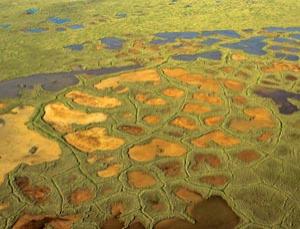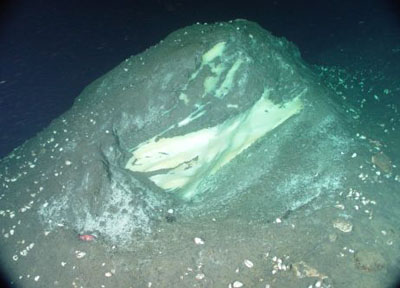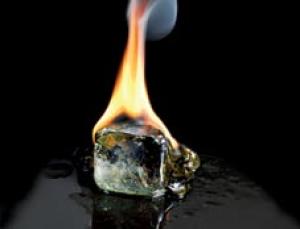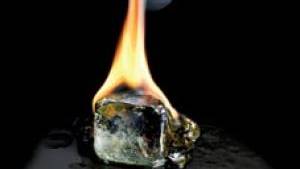Ice on fire: The next fossil fuel
Source: newscientist.com
Deep in the Arctic Circle, in the Messoyakha gas field of western Siberia, lies a mystery. Back in 1970, Russian engineers began pumping natural gas from beneath the permafrost and piping it east across the tundra to the Norilsk metal smelter, the biggest industrial enterprise in the Arctic.By the late 70s, they were on the brink of winding down the operation. According to their surveys, they had sapped nearly all the methane from the deposit. But despite their estimates, the gas just kept on coming. The field continues to power Norilsk today.
Where is this methane coming from? The Soviet geologists initially thought it was leaking from another deposit hidden beneath the first. But their experiments revealed the opposite - the mystery methane is seeping into the well from the icy permafrost above.

Frozen deposits of energy-rich clathrates could make the Siberian permafrost the new Gulf (Image: Steven Kazlowski/Science Faction/Corbis)
If unintentionally, what they had achieved was the first, and so far only, successful exploitation of methane clathrate. Made of molecules of methane trapped within ice crystals, this stuff looks like dirty ice and has the consistency of sorbet. Touch it with a lit match, though, and it bursts into flames.
Clathrates are rapidly gaining favour as an answer to the energy crisis. Burning methane emits only half as much carbon dioxide as burning coal, and many countries are seeing clathrates as a quick and easy way of reducing carbon emissions. Others question whether that is wise, and are worried that extracting clathrates at all could have unforeseen and perilous side effects.

Methane is typically stored in structures called methane hydrates, or clathrates, which are little cages of water molecules with methane molecules trapped inside. They tend to form in areas where pressures are high and temperatures are low; thus, they are often seen lining the floor at the continental shelves and are also found locked within the poles' permafrost.
If countries and companies are exploring the potential of clathrates only now, that's not for lack of scientific interest over the years. Research over the past two decades has shown that the energy trapped in ice within the permafrost and under the sea rivals that in all oil, coal and conventional gas fields, and could power the world for centuries to come. Oil and gas companies have been slow to catch on, however, believing methane clathrates to be unreliable and uneconomical. Feasibility studies and the diminishing supplies of conventional natural gas are changing that, making commercially viable production realistic within a decade, says Ray Boswell, who heads the clathrates programme at the US Department of Energy.

Burning methane trapped in ice could answer the world's energy problems (Image: Blickwinkel/Alamy)
"Just a few years ago no one was thinking about clathrates as an energy source," Boswell says. "Now there is a great deal of interest in them." It is not just the US. Canada, China and Norway are entering the race too. The governments of Japan and South Korea have given the green light for full-scale production. The first intentional commercial exploitation may come as early as 2015.
So what are methane clathrates, and where do they come from? As with all natural gas, the story starts with rotting plants. As these plants decay, they release methane, which permeates through porous rocks underground. If the conditions where the methane ends up are just right - temperatures close to 0 °C and pressures of roughly 50 atmospheres - ice crystals form that trap the gas in place.
In practice, these conditions mostly occur within and underneath permafrost and beneath the seabed on continental shelves, usually at ocean depths of 200 to 400 metres, although clathrates have also been known to appear on the seabed. In 2000, a 1-tonne chunk of the stuff was scooped up by fishermen off Vancouver Island in British Columbia. They hastily dumped the hissing mass back into the ocean.
Until recently, these deposits escaped the serious attention of energy companies. Engineers stumbled on clathrates from time to time while drilling for conventional reserves of oil and gas, but they were mostly viewed as an irritant that caused blowouts or blocked pipelines.
That view changed with studies showing that the gas is often present at a given site in concentrations of 50 per cent or more in ice's pore space - values similar to the prevalence of natural gas in traditional sources - in layers of clathrate hundreds of metres thick. What's more, in its constricted surroundings the gas is compressed to 160 times its density at atmospheric temperature and pressure, making for vast quantities of it when released.
These revelations made clathrates a potential gold mine that countries and energy companies are now eagerly prospecting. In 2007, a US project found clathrate reserves in Alaska with 80 per cent of the ice's pore space packed with methane. Tim Collett, a clathrate specialist at the US Geological Survey who was part of the team, says there may be reserves all along the Alaska north slope, including beneath existing oil installations at Prudhoe Bay and, alarmingly for environmentalists, the Arctic National Wildlife Refuge.
Collett estimates there is between 0.7 and 4.4 trillion cubic metres of methane clathrate in Alaska alone. Even the low end of that range could heat 100 million homes for a decade. "It's definitely a vast storehouse of energy. But it is still unknown how much of the volume can actually be produced on an industrial scale," he told a meeting of the American Chemical Society at Salt Lake City, Utah in March this year.
That's not the only reserve of interest. In 2004, a German and Chinese team found methane venting from the seabed off the coast of Taiwan in the South China Sea, and in 2006 Indian researchers found a layer of methane clathrates 130 metres thick off its east coast in an area known as the Krishna-Godavari basin. Collett calls these "one of the world's richest marine gas clathrate accumulations".
Estimates vary, but conservative figures place global reserves at roughly 3 trillion tonnes of previously untapped carbon - more than is trapped in all the other known fossil fuel reserves put together, says Klaus Wallmann of the Leibniz Institute of Marine Science in Kiel, Germany.
That would last about 1000 years if we continue to use natural gas at the current rate, estimates Collett. Even if the methane from clathrates replaced all fossil fuels, and not just gas, it would still last for at least 100 years. But with this methane held in fragile ice crystals and buried deep within the Earth, can it be exploited safely and economically?
Until recently, there were two methods of extracting methane from clathrates that were considered feasible. One is to drill a hole into the clathrate deposit to release the pressure, allowing the methane to separate out from the clathrate and flow up the wellhead. The second is to warm the clathrate by pumping in steam or hot water, again releasing the methane from its icy matrix.
In 2002, Canadian, American, Japanese, Indian and German researchers tested both techniques in the field, at a drill site called Mallik on the outer extremity of the Mackenzie river delta in the Canadian Arctic. Both were successful, but the energy costs of the heating method nearly outweighed the energy gained from the methane released, making depressurisation the more attractive option.
The potential of depressurisation was confirmed in March 2008, when Canadian engineers led by Scott Dallimore of the Geological Survey of Canada used the technique to tap 20,000 cubic metres of methane gas over six days from a deposit located 1 kilometre beneath Mallik.
Similarly, in 2007, South Korea exploited depressurisation to extract methane clathrate from the Ulleung basin in the Sea of Japan. Officials believe reserves there could meet the country's gas needs for up to 30 years, and they plan to begin production by 2015. Meanwhile Japan, another country with limited fossil fuel reserves, has found up to 50 trillion cubic metres of clathrate south-east of Honshu Island in the Nankai trough - enough to supply the country with natural gas for centuries. In March 2008, the Japanese cabinet pledged to begin production by 2016.
So methane clathrate extraction seems to be imminent, in Asia at least. Whether it is desirable is another matter. Some argue that the world shouldn't be tapping a new fossil fuel while we are pledging to build a low-carbon economy. Methane might be less carbon intensive than fuels such as coal, but switching to methane would not help countries to reach ambitious targets for reducing carbon emissions of up to 80 per cent by 2050.
To make matters worse, the methane itself could exacerbate global warming if it starts leaking from the reserves. Methane is, molecule for molecule, 20 times as powerful at warming the air as CO2. Rising sea temperatures could melt some undersea clathrate reserves even without extraction projects disturbing them, triggering a release of this potent greenhouse gas. A decade ago, Peter Brewer of the Monterey Bay Aquarium Research Institute in Moss Landing, California, showed how clathrates on the seabed just off the coast of California disappeared after an El Niño event raised ocean temperatures by 1 °C.
Exploitation of clathrate reserves might exacerbate this problem, but it could also have far more immediate adverse effects. Clathrates exist in a delicate balance, and the worry is that as gas is extracted its pressure will break up neighbouring clathrate crystals. The result could be an uncontrollable chain reaction - a "methane burp" that could cascade through undersea reserves, triggering landslips and even tsunamis. "Extraction increases the risk of large-scale collapses, which might have catastrophic consequences," says Geir Erlsand from the University of Bergen in Norway.
Evidence that such events have happened in the past comes from the Storegga slide, a landslip on the seabed off western Norway about 8000 years ago. A 400-kilometre stretch of submarine cliff on the edge of the continental shelf collapsed into the deep ocean, taking with it a staggering 3500 cubic kilometres of sediment that spread across an area the size of Scotland. The result would have been a tsunami comparable to the one that devastated parts of south-east Asia in 2004.
The naval researchers who first discovered the remains of the slide in 1979 assumed it was the result of an earthquake. Perhaps it was initially, but Jürgen Mienert of the University of Tromsø in Norway has found that the slumped area was also a hotspot for methane clathrates. The sheer number of cracks and giant pockmarks on the seabed, carbon-dated to the time of the slide, suggest billions of tonnes of methane must have burst out of the cliff along with the sediment, a possible trigger for the landslip. The resulting explosions would have turned even a minor slip into a major disaster.
Sinking carbon
The Storegga slide is not the only incident of this kind. The ocean floor from Storegga to Svalbard is full of pockmarks that might have been caused by similar clathrate-driven landslides, says Mienert. He says we will see more of these events in the future. "Global warming will cause more blowouts and more craters and more releases," he warns.
Other engineers believe claims that clathrate extraction poses a risk are little more than scare stories with little supporting evidence. Wallmann claims that the Chinese and Indians in particular are "afraid that the west wants to prevent them from rapid extraction of methane clathrate".
There might in fact be a safer way of tapping clathrates which, if successful, could quash the criticisms. Since other gases can also form clathrates, it should be possible to pump one of these gases into the crystals to displace the methane. Carbon dioxide would be an ideal candidate, says Ersland - the resulting crystal is even more stable than methane clathrate, meaning another greenhouse gas would be stored out of harm's way.
Ersland has already demonstrated his technique in the lab. In joint research with the energy company ConocoPhillips based in Houston, Texas, he replaced methane with CO2 in artificial clathrate crystals. The exchange was rapid and did not damage the clathrate structure, making it the safest way to extract the methane yet found (Chemical Engineering Journal, DOI: 10.1016/j.cej.2008.12.028). Substituting methane with CO2 "will increase the stability of the reservoir sediments as well as maintaining the clathrates in their solid state", Ersland says.
The acid test will be an experiment planned for January next year. ConocoPhillips intends to pour liquefied CO2 down a borehole into the Alaskan north slope's clathrate deposit. If all goes well, the CO2 will fill the clathrate crystals and the displaced methane will shoot up the wellhead to the surface. The method could be both a safe way of capturing the methane and an environmental argument for pursuing the goal - the clathrate structures would be acting as a carbon sink.
It is an intriguing possibility. Sooner rather than later, burning fossil fuels like coal and natural gas will only be acceptable if the CO2 emissions are captured and stored. Right now, there is a rush to develop a practical system for capturing and burying billions of tonnes of CO2 underground per year.
So far, the focus has been on old oil wells, salt deposits and even old coal mines. The big problem is that the huge infrastructure required to dispose of the CO2 may quickly make burning fossil fuels uneconomic compared with alternatives like solar, wind or nuclear power. Disposing of CO2 down the same pipe used to bring up more fuel could be the answer.
Article from: NewScientist.com
 Katey Walter studies methane emissions from arctic lakes, especially the connection between thawing permafrost and lakes. As permafrost around a lake's edges thaws, the organic material in it -- dead plants and amimals -- can enter the water, where bacteria convert it to methane gas, which bubbles up into the atmosphere, sometimes in spectatcular fashion.
Katey Walter studies methane emissions from arctic lakes, especially the connection between thawing permafrost and lakes. As permafrost around a lake's edges thaws, the organic material in it -- dead plants and amimals -- can enter the water, where bacteria convert it to methane gas, which bubbles up into the atmosphere, sometimes in spectatcular fashion.Video source:YouTube.com






















